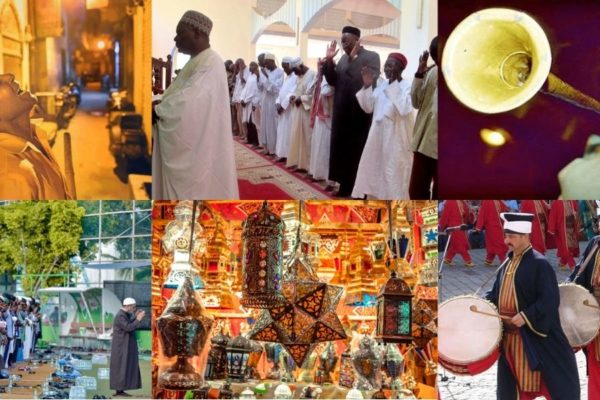Do we need more fictional stories about Imam Ali killing dragons?! How Islamic literature evolved to take holy character traits of Muslim figures and mix them with fantasy storytelling.
Do we need more fictional stories about Imam Ali killing dragons?! How Islamic literature evolved to take holy character traits of Muslim figures and mix them with fantasy storytelling.
The 1,001 Nights – also known as the Arabian Nights – can be hailed as a treasure of Islamic culture that is admired around the world. A vast and diverse collection of stories with origins stretching from Cordoba to Kashmir, it presents the tales that queen Shahrzad tells every night to distract her husband from his plan to kill her (marriage…), breaking off mid-story each morning to keep him interested. Some are filled with magic, jinn and giant birds; others detail complex intrigues between merchants, caliphs and dancing monkeys. Within any given story, the characters are compulsively prone to telling stories themselves, creating a near-endless labyrinth of stories within stories within stories.
Since selections were first translated into French in the 1700s, the 1,001 Nights has exercised an immense influence on European literature and subsequently all across the globe. Beloved variously for the humanity of its narratives, the surreal wonders that it describes, and its insights into the very nature of storytelling, the book’s influence extends from Victorian Gothic literature to contemporary fantasy franchises, inspiring authors as disparate as Haruki Murakami and Cardinal Newman. Though European literature since the Middle Ages have produced many formally similar collections of tales, none captured the imagination of modern readers like the 1,001 Nights.
The popularity of the 1,001 Nights, however, also has a sinister side. Even as Europeans over the past three centuries delighted in the many treasures of Shahrzad’s stories, they also brought other, bloodier forms of treasure extraction to Muslim-majority countries. Fascination with the 1,001 Nights blurred into a vision of Muslims as exotic others, denizens of a magical, timeless ‘Orient’, one that needed to have European rationality, modernity and progress thrust upon it. Paradoxically, even as the 1,001 Nights inspired new leaps of fiction and fantasy, orientalist scholars recommended it as a reliable guide to real ‘Oriental’ culture. Needless to say, the impulse to see the Muslim world (wherever that is) as somewhere for the West to play out its fantasies, be it in politics or in cinema, is still very much with us, and still echoes with motifs born in the early translations of 1,001 Nights.
This history complicates any easy celebration of the 1,001 Nights’ influence, but it also bids us ask how much these stories actually have to do with Islam. Ironically given colonisers’ enthusiasm for the 1,001 Nights as a guide to the Muslim mind, historically, Shahrzad and her tales have not attracted much direct attention from Muslim authors. Though Muslims have been writing and reading such story collections for over a thousand years, these were rarely taken seriously by religious and literary scholars; when they are mentioned, it is usually only to dismiss them as childish fables for the feeble-minded.
This attitude is not just the case of one book; the impulse to regard fictional storytelling in general with considerable suspicion is a powerful and pervasive one in many strands of Muslim intellectual history. Some authors criticise even great imaginative works like Ferdowsi’s Book of Kings as a waste of time (‘it’s all made-up, so what’s the point?’), and there is an especially deep mistrust of such narrative creativity coming anywhere near religion. Perhaps understandably, hadith scholars who spent all their time carefully sifting authentic texts from forgeries were often vehemently impatient with religious storytellers (important figures in many Muslim-majority societies) whose approach to historical accuracy was a little more flexible.
This is not the whole story, however. Islamic history is also filled with traditions and schools of thought in which stories are not just an idle pastime but a vital means of conveying religious truth. Muslim civilisations boast legions of great storytellers, among them Sufi poets like Attar and Jami and philosophers like Ibn Sina and Suhrawardi. When Rumi tells the story of the merchant who accidentally causes his parrot to go bald, or when Ibn Tufayl tells the story of how a single human born alone on an isolated island uses pure reason to work out the truths of God’s existence, nobody complains that these things didn’t actually happen. These authors are not out to write history. Rather they use stories as powerful vehicles of meaning, elucidating mysteries that can’t be explained by other means.
As the 1,001 Nights itself repeatedly illustrates, this range of Muslim attitudes reflects the ambiguous nature of storytelling itself. On the one hand, humans are imaginative creatures, and any account of humanity that excludes the imagination will never work. On the other hand, the imagination can also produce lies, delusions and distractions. Shahrzad is trying (not unjustifiably) to trick her husband, though perhaps her stories will make him wiser, too, as time goes by. The Qur’an’s own use of narrative explores this same tension: it condemns those who dismiss its accounts of previous prophets as mere legends (asatir). It also often presents the stories it tells as parables (amthal) from which the faithful are encouraged to derive wisdom.
Writers like Rumi and Sa’di are still widely celebrated, but the history of Islamic religious storytelling also includes some chapters that contemporary Muslims can find rather shocking. For example, it is not unusual to find Muslim authors taking revered characters from the Prophet’s biography and casting them in narratives that are completely unabashedly fictional. In his epic poem, the Khavaran Nameh, the fifteenth-century Persian poet Ibn Husam Khusfi reimagines Imam Ali as a kind of medieval superhero, charging across a fantastical landscape on the back of his multicoloured mule Duldul, outwitting demons, slaying dragons, and rescuing his companions from a variety of bewildering situations that sometimes involve robotic birds. Better known today are the many stories told about Amir Hamza, still popular in much of South and Southeast Asia, in which the Prophet’s uncle Hamza has a similar set of endlessly fantastical adventures with jinn, princesses and enchanted artefacts, almost all of them a very long way from historical Arabia.
In a world where we are used to endless arguments over what actually happened, it is a little counterintuitive to see Muslim authors use the lives of the Prophet’s closest relatives as material for such raucous outpourings of make-believe. These authors and their readers, however, didn’t think they were doing anything wrong: they were not out to contradict the essential work of hadith scholars and historians, only to play a different, complimentary role, using their stories’ mixtures of the fictional and the sacred to inspire broader audiences, entertaining them even as they explored the nature of holiness. For Ibn Husam Khusfi, the improbable situations in which he imagines Ali simply allow him to illustrate the true, wondrous scale of Ali’s wisdom, courage and humility.
Debates over the value of such stories are nothing new and will doubtless continue; whether the umma needs more poems about Ali killing dragons remains to be seen. Nevertheless, it is important to note that the strangeness with which these narratives now often strike us has a lot to do with things that have only changed over the past 200 years. Alongside many other challenges brought by colonialism, Muslims all over the world have been relentlessly compelled to resist the catastrophic Euro-American impulse to treat Muslim-majority societies as some kind of timeless, irrational fantasy land. Such resistance often involves playing down anything in their traditions that could be seen as unscientific – a category that still usually includes dragons, and certainly used to include giant mechanical birds. In contexts where even vastly sophisticated Sufi anthropocosmologies were dismissed as nonsense, it is easy to see how the story of Amar, the wizards and the magical destroying egg went out of fashion.
Today, the 1,001 Nights is a truly global cultural presence, one that is continually encountered in literature faculties, in art galleries, in Hollywood films and beyond. This is certainly part of a complex legacy, enmeshed with a history of deeply troubling colonial attitudes that have not gone away. Nevertheless, the magic of these stories cannot be reduced simply to bored, strangely-dressed aristocrats seeking a phantasmagorical holiday from Dickensian London. Shahrzad’s tales are part of a robust, millennium-long Islamic tradition of fantastical storytelling, one that continues to be drawn upon by countless Muslim writers and artists. The characters in these stories are sometimes saints and heroes, sometimes thieves and reprobates, but usually they are just human(ish) beings to whom weird, weird things keep on happening – people on the receiving end of an impossible universe, shaped by the hand of an all-powerful, endlessly creative God.





